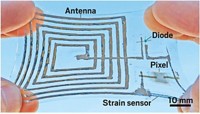Advertisement
Grab your lab coat. Let's get started
Welcome!
Welcome!
Create an account below to get 6 C&EN articles per month, receive newsletters and more - all free.
It seems this is your first time logging in online. Please enter the following information to continue.
As an ACS member you automatically get access to this site. All we need is few more details to create your reading experience.
Not you? Sign in with a different account.
Not you? Sign in with a different account.
ERROR 1
ERROR 1
ERROR 2
ERROR 2
ERROR 2
ERROR 2
ERROR 2
Password and Confirm password must match.
If you have an ACS member number, please enter it here so we can link this account to your membership. (optional)
ERROR 2
ACS values your privacy. By submitting your information, you are gaining access to C&EN and subscribing to our weekly newsletter. We use the information you provide to make your reading experience better, and we will never sell your data to third party members.
Materials
Data Storage Goes Organic
Materials Science: Device relies on changes in azo conductivity
by Sophie L. Rovner
April 12, 2010
| A version of this story appeared in
Volume 88, Issue 15
A data-storage system based on a new azo compound could increase the memory capacity of future electronic devices.
Most electronic memory systems use binary data storage, in which data are recorded as a string of zeros and ones. However, a few ternary systems—mostly experimental—have been developed that record data as zero, one, or two. In principle, the additional value means that a ternary system can hold much more data than a binary system does in a given amount of space within a storage device.
Now, Jianmei Lu, Hongwei Gu, and colleagues at Soochow University, in Suzhou, China, have devised a new ternary system (J. Am. Chem. Soc., DOI: 10.1021/ja910243f). The researchers synthesized the azo compound and sandwiched it between indium tin oxide (ITO) and aluminum electrodes. Each aluminum electrode, along with the small region of the azo material and ITO directly below it, serves as a memory storage unit, akin to the individual magnetized patches in which data are stored on a hard-drive disk.
Applying a voltage to an aluminum electrode permanently alters the density of molecular stacking—and the ease with which electrons flow—in the azo material below that electrode. The strength of the applied voltage determines whether that region of the azo layer ends up in a low-, medium-, or high-conductivity state, corresponding to zero, one, or two, respectively.
Lu and Gu’s prototype is a “write once, read many times” device, which is useful for permanent data storage. The researchers are looking for new materials that allow data to be erased and rewritten.
The proof-of-concept device is the first in which an organic molecule reliably provides three distinct, electrically switchable states for nonerasable memory storage, according to University of Pennsylvania materials scientist Ritesh Agarwal. Agarwal’s group previously developed a reliable erasable ternary data-storage system based on inorganic materials that change conductivity as an electric field switches the compounds from an amorphous to crystalline state and back (Nano Lett. 2008, 8, 2056).






Join the conversation
Contact the reporter
Submit a Letter to the Editor for publication
Engage with us on Twitter